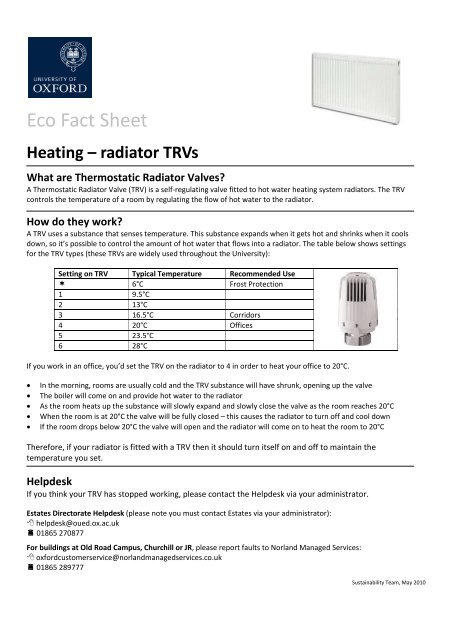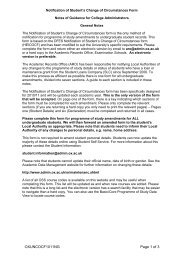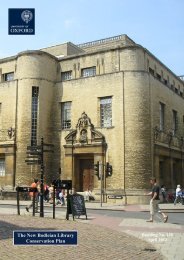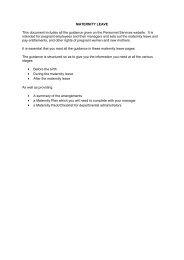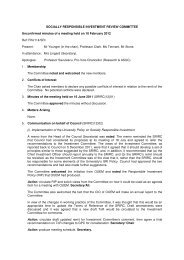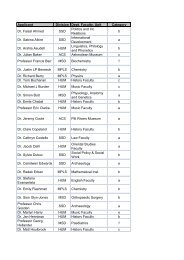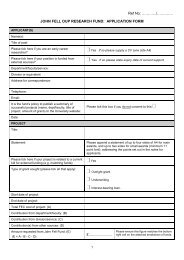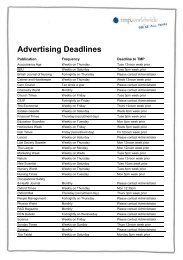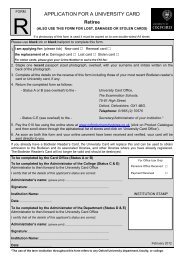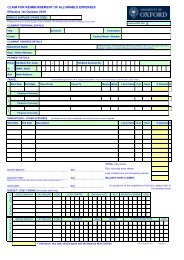Eco Fact Sheet - University of Oxford
Eco Fact Sheet - University of Oxford
Eco Fact Sheet - University of Oxford
You also want an ePaper? Increase the reach of your titles
YUMPU automatically turns print PDFs into web optimized ePapers that Google loves.
<strong>Eco</strong> <strong>Fact</strong> <strong>Sheet</strong>Heating – radiator TRVsWhat are Thermostatic Radiator Valves?A Thermostatic Radiator Valve (TRV) is a self‐regulating valve fitted to hot water heating system radiators. The TRVcontrols the temperature <strong>of</strong> a room by regulating the flow <strong>of</strong> hot water to the radiator.How do they work?A TRV uses a substance that senses temperature. This substance expands when it gets hot and shrinks when it coolsdown, so it’s possible to control the amount <strong>of</strong> hot water that flows into a radiator. The table below shows settingsfor the TRV types (these TRVs are widely used throughout the <strong>University</strong>):Setting on TRV Typical Temperature Recommended Use 6°C Frost Protection1 9.5°C2 13°C3 16.5°C Corridors4 20°C Offices5 23.5°C6 28°CIf you work in an <strong>of</strong>fice, you’d set the TRV on the radiator to 4 in order to heat your <strong>of</strong>fice to 20°C.• In the morning, rooms are usually cold and the TRV substance will have shrunk, opening up the valve• The boiler will come on and provide hot water to the radiator• As the room heats up the substance will slowly expand and slowly close the valve as the room reaches 20°C• When the room is at 20°C the valve will be fully closed – this causes the radiator to turn <strong>of</strong>f and cool down• If the room drops below 20°C the valve will open and the radiator will come on to heat the room to 20°CTherefore, if your radiator is fitted with a TRV then it should turn itself on and <strong>of</strong>f to maintain thetemperature you set.HelpdeskIf you think your TRV has stopped working, please contact the Helpdesk via your administrator.Estates Directorate Helpdesk (please note you must contact Estates via your administrator): helpdesk@oued.ox.ac.uk 01865 270877For buildings at Old Road Campus, Churchill or JR, please report faults to Norland Managed Services: oxfordcustomerservice@norlandmanagedservices.co.uk 01865 289777Sustainability Team, May 2010
Other types <strong>of</strong> TRVSetting on TRV Typical Temperature Recommended Use 8°C Frost Protection1 10°C2 13.5°C3 17°C Corridors4 20.5°C Offices5 24°CMAX 27°CSetting on TRV Typical Temperature Recommended Use 8°C Frost Protection1 12°C2 16°C Corridors3 20°C Offices4 24°C5 28°CSetting on TRV Typical Temperature Recommended Use 7°C Frost Protection1 12°C2 16°C Corridors3 20°C Offices4 24°C5 28°CSetting on TRV Typical Temperature Recommended Use 6°C Frost Protection1 11°C2 14°C3 17°C Corridors4 20°C Offices5 23°C6 26°CIf none <strong>of</strong> the above TRVs are used on your radiator then we recommend you set it to 3 or 4 for optimum comfort andenergy saving.<strong>University</strong> Energy Policy & TargetsThe <strong>University</strong> <strong>of</strong> <strong>Oxford</strong> Energy Policy is to reduce its buildings and process carbon dioxide emissions in line with UKgovernment carbon dioxide emissions reduction targets. <strong>University</strong>’s energy targets:• To reduce CO 2 emissions by between 3%‐10% by March 2011 compared to 2009/10 emission levels• To reduce CO 2 emissions by 34% by 2020 compared to 1990 emission levels• To reduce CO 2 emissions by 80% by 2050 compared to 1990 emission levelsContactsEnergy Conservation Engineer – Philip Pike (philip.pike@oued.ox.ac.uk) 01865 278780Ass. Energy Conservation Engineer – Jonathan Walford (jonathan.walford@oued.ox.ac.uk) 01865 278779Sustainability Team, May 2010


